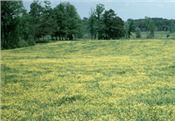Buttercup: Blistering Beauty Poisons Cattle

All parts of the buttercup plant are toxic to livestock. It is less toxic in dried hay.
Photo courtesy of Sarah Kenyon.
COLUMBIA, MO.
The buttercup’s beauty belies its blistering poison. All parts of the perennial pasture crop are poisonous, says University of Missouri Extension field specialist in agronomy Sarah Kenyon.
Buttercup, the name given to species in the genus Ranunculus, is short-lived, flowering from March to August. It emerges from seed and/or corm during the fall and winter and makes a low-growing thick carpet. It bolts in early spring and produces a shiny, five-petal flower with crowfoot-shaped leaves divided into three sections.
When cattle and other livestock eat buttercup, its toxins blister the mouth and cause gastrointestinal irritation. Grazing it in large quantities causes convulsions and death. “Because of the immediate effects, livestock tend to avoid the plant,” Kenyon says.
Buttercup’s toxins volatilize when dried, so it is less toxic in dried hay. Call a veterinarian immediately if poisoning is suspected and remove livestock from the grazing area until all poisonous plants have been destroyed, she says.
Mow to reduce seed production. However, mowing may not be effective as buttercup flowers below the mow line.
Properly timed herbicide application helps eliminate buttercup. Spray in the spring before flowering. Applying herbicides now will not provide control, Kenyon says. Consult your local MU Extension center for the most effective solution for your area.
One of the best ways to prevent buttercup in pastures is to maintain good pasture stands, says MU Extension agronomist Anthony Ohmes. Buttercup is more common in continuously grazed pastures, especially in overgrazed areas.
For more information on pasture weed management, contact your regional MU Extension agronomist or see MU weed scientist Kevin Bradley’s abstract to “Weed and Brush Control for Forages, Pastures and Noncropland” at extension2.missouri.edu/ipm1031. ∆